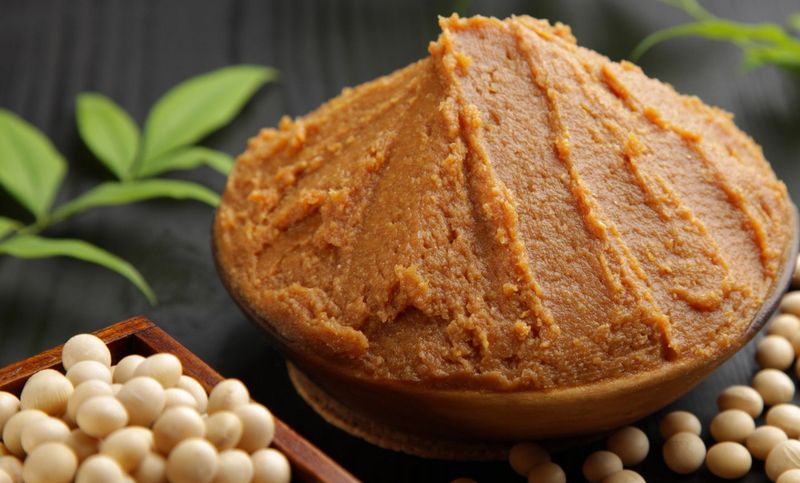Have you ever tried a hot miso soup? It may look like a simple dish, but it is really tastier. Miso paste gives the dish its tasty umami flavor that also makes other Japanese dishes uniquely delectable.
If you are into Japanese cuisines, then you probably wonder how long you could keep miso paste in your kitchen because this is a common ingredient in most Japanese recipes.
How long can I store miso paste? Can I refrigerate it or freeze it? The answer is, definitely.
It is suggested that you freeze miso paste to keep its taste from changing after some time, and to give it a longer shelf life than just leaving it in the cupboard.
Remember that miso paste has a thick consistency so you need to know the right techniques of storing it so it will be easier for you to use it after thawing.
You can follow our simple steps or ways in keeping your miso paste in the freezer.
Freezing Miso Paste
- Pack miso paste in a tightly sealed freezer bag. To keep it from airborne bacterial and other contaminants, it is best to store it by packing or placing it in an airtight or tightly sealed freezer bag. It will also be easy to place it in your freezer and flatten it.
- Freeze miso paste using ice cube trays. Place miso in each packet of the ice cube tray and have it frozen in sizeable amounts. It will be easier to get the amount or portion of miso you will need for cooking by simply removing one from each packet than opening a freezer bag and thaw the whole lot.
- Frozen miso paste remains malleable. It will not completely turn to ice when frozen so you can also opt to put it in an airtight container with lid for freezing. You can use a spoon or a scooper to get an ample amount you need from the container without the need of thawing the whole lot.
- Package the paste in small food containers separately. It is also easier to keep the miso frozen separately using small food containers. It will be handy to just get one small container that you will need for cooking rather than a huge single container to get only a small portion you need.
Since miso paste is made from fermented soybeans, it really has longer shelf life. When packaged properly and frozen, it can last to one year. However, there are two kinds of miso, the light miso and dark miso. Dark miso has a longer shelf life than white miso even when frozen.

What Does Miso Taste Like?
If you fancy Japanese cuisines, then you are familiar with how miso taste like. If you are not, think of miso paste as brownish or reddish paste with a salty and tangy taste. Its taste is a bit strong when eaten just as it is.
Miso paste is not typically prepared as it is or eaten a condiment. It is used as additional ingredient to add the tang of umami taste in different recipes like soups, sauces, salads, stir fries, and marinades.
The miso paste is made naturally by fermenting soybeans, so it is really healthy. It is rich in good bacteria or probiotics that aids our digestive system. Keep in mind however that probiotics die when exposed to high heat or boiled, so it is recommended to just heat it or warm it to keep the good bacteria.
Miso Varieties
The use of miso originated in Japan and different regions in Japan has their own way and length of time spent in fermenting the soybeans to make miso paste. This results to different varieties of miso available in the market.
If it is your first time to prepare a dish with miso paste, keep in mind that miso with dark color has stronger taste than light colored miso. The whitish or yellowish miso typically tastes less salty and less tangy than the brownish miso.
Since there are also manufacturers of miso paste, you need to look at the product label to know whether it is free from gluten or if you might have some allergy with the ingredients used.
Here are different kinds of miso paste you can cook with:
Kome miso
Kome is known as the traditional type of miso paste made from fermented soybeans. It comes in reddish or whitish color and has sweeter taste. It also has a variety of yellow miso or red miso paste that is considered fully flavored or has strong taste.
Mame miso
Mame is available in brownish color and is usually dark. It is produced from rice malt and has strong taste or flavor.
Mugi miso
This type of miso is produced by fermenting barley malt. It has light yellowish color and also has sweeter taste. The variety of mugi miso which is reddish in color has a salty and flavorful taste.
Shiro miso
This type of miso in common in western countries. It is produced by combining fermented soybeans and rice malt. It is less flavorful or not as salty as the traditional miso paste.
All of these miso types are used in Japanese recipes. It gives the dish its umami flavor that identifies a traditional Japanese dish.
Where Can I Find Miso Paste?
The popularity of Japanese cuisines in different countries made the miso paste available in many grocery stores or supermarkets. It is always refrigerated so you can find in the refrigerated food section of the store.
If you want the authentic miso paste made from fermented soybeans, always check the label of the miso before buying it.
Related Questions
What can I cook with miso paste?
Japanese commonly use miso to add flavor to their dishes so you can see it as ingredient to many Japanese recipes. It can add flavor or a distinct umami taste in soups, noodles, stir-fries, stews, and vegetables. It can also be added to your salad dressing. You can also add miso paste to any of your recipes as long as you want that tangy taste of the dish.
Is miso paste healthy to eat?
Since it is made from fermented soybeans, it is rich in minerals and vitamins which are good for our health. It has high amount of vitamin K, iron, zinc, phosphorus, and protein. It is also the best source of probiotics or good bacteria which aids our digestive system and promotes healthy guts.
Although, you must keep in mind that probiotics die when boiled or when subjected to very high temperature. It is recommended to just heat it or warm it with your dish and not to boil it. It also best to store or keep miso frozen or refrigerated to preserve the good microorganisms in it.
To those who needs to check their sodium intake, this has high sodium so it will not be good for them.
What can be used as substitute to miso paste?
Miso has a unique taste that no other ingredient was able to replicate its distinct umami tang in a recipe. In case you need miso paste in your recipe, it is easy to find it in different grocery stores so looking for substitute will not really become a problem.
Do I need to refrigerate miso paste?
Miso has high contents of good bacteria or probiotics that makes it very healthy. These bacteria thrives in colder temperature, so it is recommended that you keep it refrigerated or frozen. However, if your freezer or fridge is full, it could still be best to store it in your cupboard. Be sure it is in a tightly sealed container to avoid contaminants from spoiling it.
Can you eat miso paste raw?
You can eat miso in raw form because it has been fermented, but it tastes very salty and you might not like its strong umami flavor. Though others can eat it raw, most people preferred it cooked to flavor their favorite dishes.
Freezing Miso Paste
Keeping your miso in the freezer is the best way to store it for a longer period of time than by simply refrigerating it. You can place it in a freezer bag or a food container and get only the amount you need to add to your dish. It is suggested though that it will be easier to store it in small food containers separately or to use an ice cube tray to freeze it in small amounts so you need not open the whole lot when you only need some.


